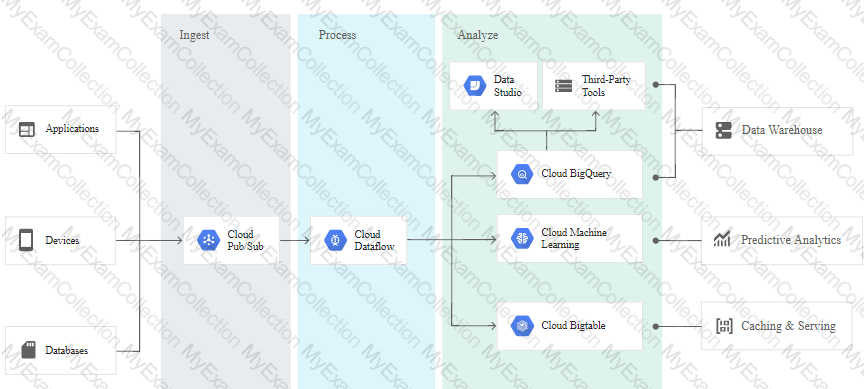For this question, refer to the TerramEarth case study. You need to implement a reliable, scalable GCP solution for the data warehouse for your company, TerramEarth. Considering the TerramEarth business and technical requirements, what should you do?
For this question, refer to the TerramEarth case study.
You start to build a new application that uses a few Cloud Functions for the backend. One use case requires a Cloud Function func_display to invoke another Cloud Function func_query. You want func_query only to accept invocations from func_display. You also want to follow Google's recommended best practices. What should you do?
TerramEarth has about 1 petabyte (PB) of vehicle testing data in a private data center. You want to move the data to Cloud Storage for your machine learning team. Currently, a 1-Gbps interconnect link is available for you. The machine learning team wants to start using the data in a month. What should you do?
For this question, refer to the Helicopter Racing League (HRL) case study. Recently HRL started a new regional
racing league in Cape Town, South Africa. In an effort to give customers in Cape Town a better user
experience, HRL has partnered with the Content Delivery Network provider, Fastly. HRL needs to allow traffic
coming from all of the Fastly IP address ranges into their Virtual Private Cloud network (VPC network). You are
a member of the HRL security team and you need to configure the update that will allow only the Fastly IP
address ranges through the External HTTP(S) load balancer. Which command should you use?
For this question, refer to the Helicopter Racing League (HRL) case study. Your team is in charge of creating a
payment card data vault for card numbers used to bill tens of thousands of viewers, merchandise consumers,
and season ticket holders. You need to implement a custom card tokenization service that meets the following
requirements:
• It must provide low latency at minimal cost.
• It must be able to identify duplicate credit cards and must not store plaintext card numbers.
• It should support annual key rotation.
Which storage approach should you adopt for your tokenization service?
For this question, refer to the Helicopter Racing League (HRL) case study. HRL is looking for a cost-effective
approach for storing their race data such as telemetry. They want to keep all historical records, train models
using only the previous season's data, and plan for data growth in terms of volume and information collected.
You need to propose a data solution. Considering HRL business requirements and the goals expressed by
CEO S. Hawke, what should you do?
For this question, refer to the Helicopter Racing League (HRL) case study. The HRL development team
releases a new version of their predictive capability application every Tuesday evening at 3 a.m. UTC to a
repository. The security team at HRL has developed an in-house penetration test Cloud Function called Airwolf.
The security team wants to run Airwolf against the predictive capability application as soon as it is released
every Tuesday. You need to set up Airwolf to run at the recurring weekly cadence. What should you do?
For this question, refer to the JencoMart case study
A few days after JencoMart migrates the user credentials database to Google Cloud Platform and shuts down the old server, the new database server stops responding to SSH connections. It is still serving database requests to the application servers correctly. What three steps should you take to diagnose the problem? Choose 3 answers
For this question, refer to the JencoMart case study.
The JencoMart security team requires that all Google Cloud Platform infrastructure is deployed using a least privilege model with separation of duties for administration between production and development resources. What Google domain and project structure should you recommend?
Your company has a Google Workspace account and Google Cloud Organization Some developers in the company have created Google Cloud projects outside of the Google Cloud Organization
You want to create an Organization structure that allows developers to create projects, but prevents them from modifying production projects You want to manage policies for all projects centrally and be able to set more restrictive policies for production projects
You want to minimize disruption to users and developers when business needs change in the future You want to follow Google-recommended practices How should you design the Organization structure?
You want to establish a Compute Engine application in a single VPC across two regions. The application must communicate over VPN to an on-premises network. How should you deploy the VPN?
Your company has a support ticketing solution that uses App Engine Standard. The project that contains the App Engine application already has a Virtual Private Cloud(VPC) network fully
connected to the company’s on-premises environment through a Cloud VPN tunnel. You want to enable App Engine application to communicate with a database that is running in the company’s on-premises environment. What should you do?
You need to reduce the number of unplanned rollbacks of erroneous production deployments in your company's web hosting platform. Improvement to the QA/Test processes accomplished an 80% reduction. Which additional two approaches can you take to further reduce the rollbacks? Choose 2 answers
For this question, refer to the Mountkirk Games case study
Mountkirk Games needs to create a repeatable and configurable mechanism for deploying isolated application environments. Developers and testers can access each other's environments and resources, but they cannot access staging or production resources. The staging environment needs access to some services from production.
What should you do to isolate development environments from staging and production?
For this question, refer to the Mountkirk Games case study.
Mountkirk Games wants you to design their new testing strategy. How should the test coverage differ from their existing backends on the other platforms?
For this question, refer to the Mountkirk Games case study.
Mountkirk Games' gaming servers are not automatically scaling properly. Last month, they rolled out a new feature, which suddenly became very popular. A record number of users are trying to use the service, but many of them are getting 503 errors and very slow response times. What should they investigate first?
For this question, refer to the Mountkirk Games case study.
Mountkirk Games wants to set up a real-time analytics platform for their new game. The new platform must meet their technical requirements. Which combination of Google technologies will meet all of their requirements?
For this question, refer to the TerramEarth case study.
TerramEarth's CTO wants to use the raw data from connected vehicles to help identify approximately when a vehicle in the development team to focus their failure. You want to allow analysts to centrally query the vehicle data. Which architecture should you recommend?
A)
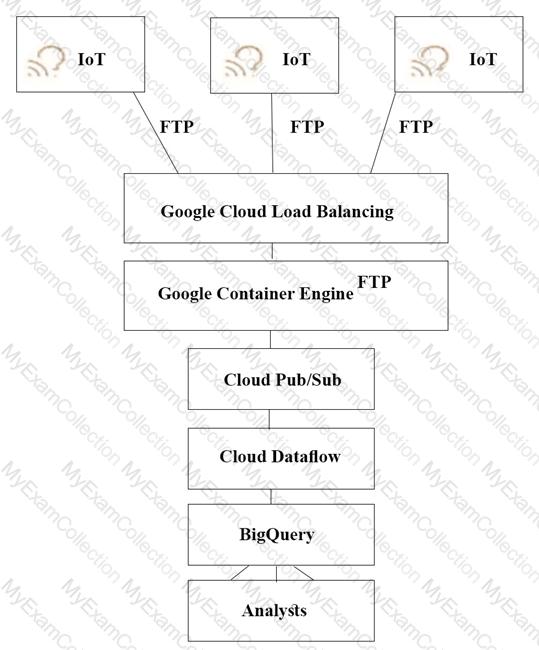
B)
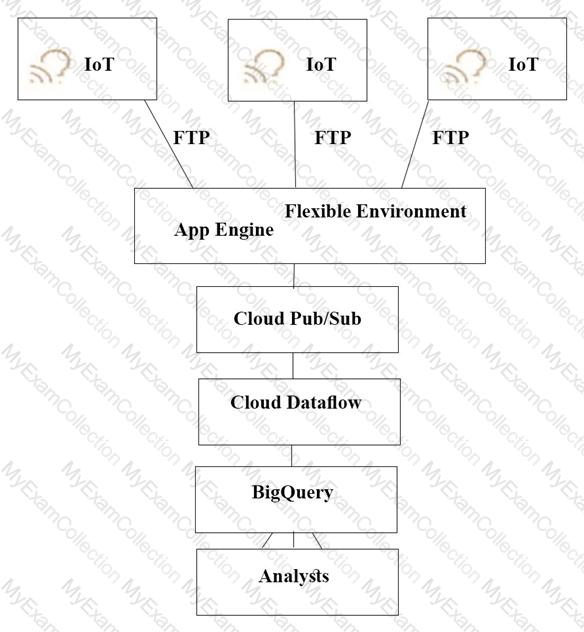
C)
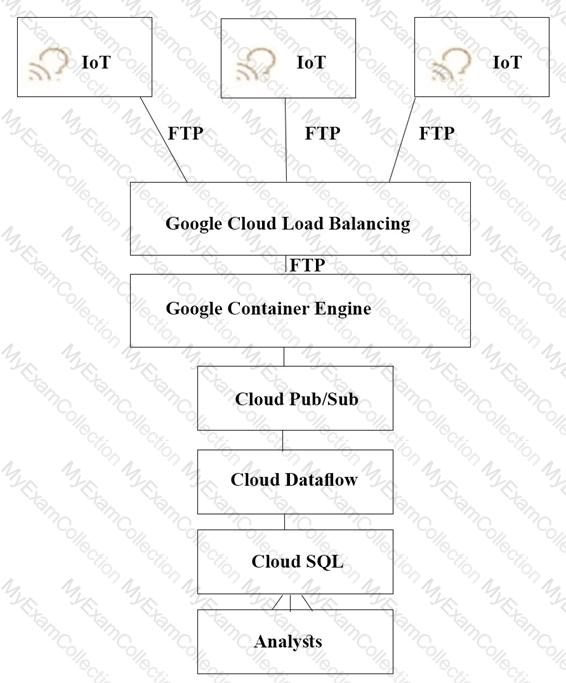
D)
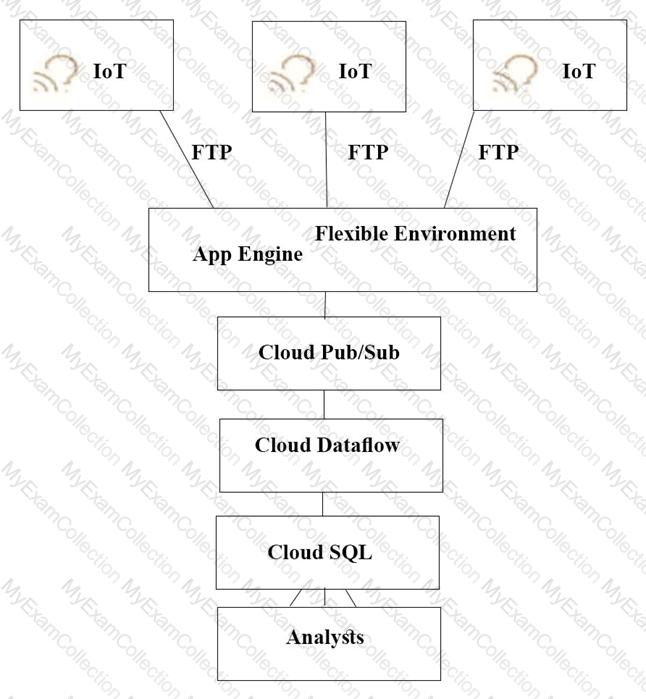
For this question, refer to the TerramEarth case study.
The TerramEarth development team wants to create an API to meet the company's business requirements. You want the development team to focus their development effort on business value versus creating a custom framework. Which method should they use?
For this question, refer to the TerramEarth case study.
TerramEarth has equipped unconnected trucks with servers and sensors to collet telemetry data. Next year they want to use the data to train machine learning models. They want to store this data in the cloud while reducing costs. What should they do?
For this question, refer to the TerramEarth case study
Your development team has created a structured API to retrieve vehicle data. They want to allow third parties to develop tools for dealerships that use this vehicle event data. You want to support delegated authorization against this data. What should you do?
For this question, refer to the Dress4Win case study. Dress4Win is expected to grow to 10 times its size in 1 year with a corresponding growth in data and traffic that mirrors the existing patterns of usage. The CIO has set the target of migrating production infrastructure to the cloud within the next 6 months. How will you configure the solution to scale for this growth without making major application changes and still maximize the ROI?
For this question, refer to the Dress4Win case study. Considering the given business requirements, how would you automate the deployment of web and transactional data layers?
For this question, refer to the Dress4Win case study. You are responsible for the security of data stored in
Cloud Storage for your company, Dress4Win. You have already created a set of Google Groups and assigned the appropriate users to those groups. You should use Google best practices and implement the simplest design to meet the requirements.
Considering Dress4Win’s business and technical requirements, what should you do?
For this question, refer to the JencoMart case study.
JencoMart has built a version of their application on Google Cloud Platform that serves traffic to Asia. You want to measure success against their business and technical goals. Which metrics should you track?
For this question, refer to the JencoMart case study.
JencoMart wants to move their User Profiles database to Google Cloud Platform. Which Google Database should they use?
For this question, refer to the Dress4Win case study. To be legally compliant during an audit, Dress4Win must be able to give insights in all administrative actions that modify the configuration or metadata of resources on Google Cloud.
What should you do?
For this question, refer to the Mountkirk Games case study. Mountkirk Games wants to migrate from their current analytics and statistics reporting model to one that meets their technical requirements on Google Cloud Platform.
Which two steps should be part of their migration plan? (Choose two.)
Your development teams release new versions of games running on Google Kubernetes Engine (GKE) daily.
You want to create service level indicators (SLIs) to evaluate the quality of the new versions from the user’s
perspective. What should you do?
You need to optimize batch file transfers into Cloud Storage for Mountkirk Games’ new Google Cloud solution.
The batch files contain game statistics that need to be staged in Cloud Storage and be processed by an extract
transform load (ETL) tool. What should you do?
For this question, refer to the Mountkirk Games case study. You need to analyze and define the technical architecture for the compute workloads for your company, Mountkirk Games. Considering the Mountkirk Games business and technical requirements, what should you do?
For this question, refer to the EHR Healthcare case study. You are a developer on the EHR customer portal team. Your team recently migrated the customer portal application to Google Cloud. The load has increased on the application servers, and now the application is logging many timeout errors. You recently incorporated Pub/Sub into the application architecture, and the application is not logging any Pub/Sub publishing errors. You want to improve publishing latency. What should you do?
For this question, refer to the EHR Healthcare case study. You are responsible for designing the Google Cloud network architecture for Google Kubernetes Engine. You want to follow Google best practices. Considering the EHR Healthcare business and technical requirements, what should you do to reduce the attack surface?
For this question, refer to the EHR Healthcare case study. You need to define the technical architecture for securely deploying workloads to Google Cloud. You also need to ensure that only verified containers are deployed using Google Cloud services. What should you do? (Choose two.)
For this question, refer to the Dress4Win case study.
As part of their new application experience, Dress4Wm allows customers to upload images of themselves. The customer has exclusive control over who may view these images. Customers should be able to upload images with minimal latency and also be shown their images quickly on the main application page when they log in. Which configuration should Dress4Win use?
For this question, refer to the Dress4Win case study.
Dress4Win has end-to-end tests covering 100% of their endpoints. They want to ensure that the move to the cloud does not introduce any new bugs. Which additional testing methods should the developers employ to prevent an outage?
For this question, refer to the EHR Healthcare case study. EHR has single Dedicated Interconnect
connection between their primary data center and Googles network. This connection satisfies
EHR’s network and security policies:
• On-premises servers without public IP addresses need to connect to cloud resources
without public IP addresses
• Traffic flows from production network mgmt. servers to Compute Engine virtual
machines should never traverse the public internet.
You need to upgrade the EHR connection to comply with their requirements. The new
connection design must support business critical needs and meet the same network and
security policy requirements. What should you do?
